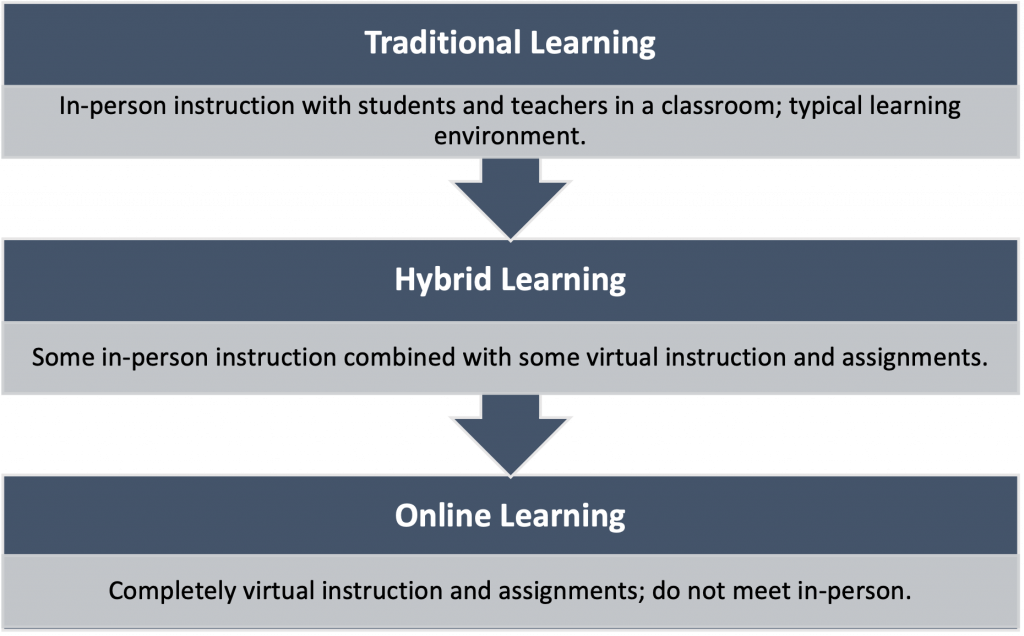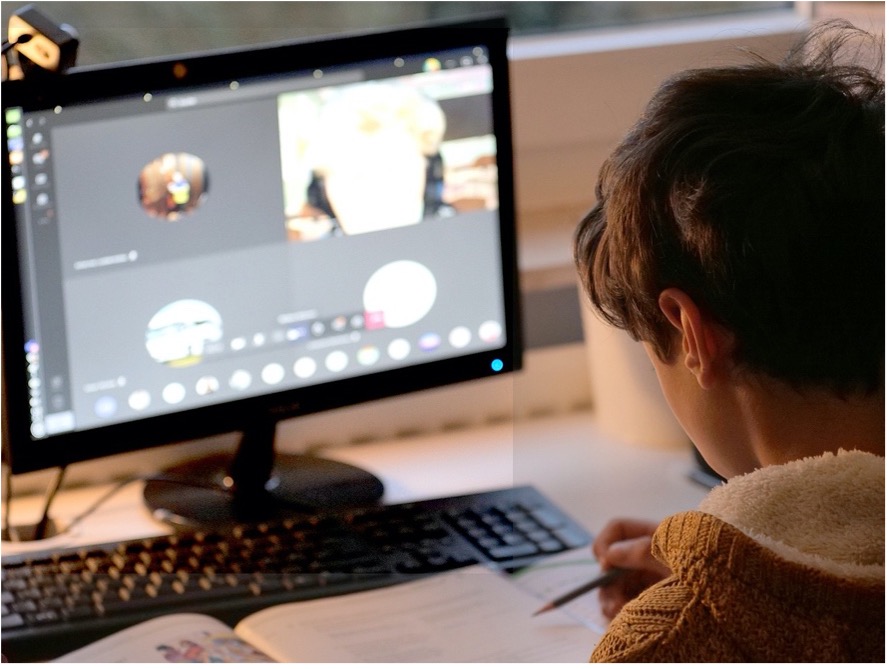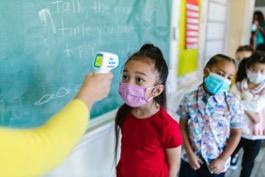14 Educational Technologies During COVID-19
Macy Brenegan
14.1 Introduction
Keywords
- COVID-19– infectious respiratory disease caused by the SARS-CoV-2 virus
- Pandemic – a large-spread outbreak of an infectious disease; usually affects an entire country or the whole world (global pandemic)
- Lockdown – government order for people or a community to stay at home in order to protect themselves and others from a foreseen risk
- Online/Virtual/Remote learning – no in-person instruction; all classes and assignments take place at home on a student’s computer
- Hybrid learning – some in-person instruction combined with some virtual instruction and assignments
- Traditional learning – in-person instruction with students and teachers in a classroom; typical learning environment
- Synchronous – students are learning at the same time
- Asynchronous – students are not learning at the same time or the same place
- Zoom – video communication software used for conferences, meetings, education, and personal use
- Learning management system – software application used to manage online learning
Learning Objectives
By the end of this chapter, students should be able to:
- Describe how the COVID-19 pandemic led to the use of online learning technologies
- Describe the main online learning technologies and their features
- Understand the effects of online learning technologies on students
Have you ever woken up in the morning and wished you could do school from the comfort of your own bed? Getting to stay home from school is every kid’s dream, and it quickly became reality for billions of students in March of 2020. When the COVID-19 pandemic swept the globe, a rush of online educational technologies also came with it to accommodate students having to learn from home. Many different online platforms such as Zoom, Canvas, Google, and more, provided a space for online classrooms when traditional, in-person learning was no longer a possibility.
Whether or not students were completely virtual, using these online technologies as a method of learning was a huge adjustment for all. As many would suspect, it greatly affected students’ learning in negative ways. The educational technologies introduced during the COVID-19 pandemic were necessary for the continuation of learning, however they do not equate to in-person learning and rather hinder student success. In this chapter, we will be discussing the different online learning technologies, where they came from, their positive and negative effects, and the outlook on these technologies.
14.2 Online Learning Technologies
Key Takeaway
Online educational technologies can be used in both hybrid and virtual learning environments. In a completely virtual/online learning environment, students complete all instruction and assignments at home. Within online learning, material can be synchronous, meaning the students meet with their teacher virtually, or asynchronous, meaning students complete all work and assignments on their own. Hybrid learning allows for limited in-person instruction in combination with online instruction and assignments. Traditional learning is a normal classroom setting and does not typically see any of the technologies that will be discussed.

Created by Macy Brenegan
14.2.1 Zoom
Zoom is an online cloud meeting platform utilized by many schools. Its technology is similar to Skype, however this video conferencing website was designed for meetings, webinars, and other online events. A Zoom call displays squares with each participant’s camera and allows options for screen sharing, breakout rooms, polls, and annotations. Using Zoom as a virtual classroom allows for much more interaction than just watching pre-recorded lessons. Students are able to see their classmates with the video feature. Students can also unmute to participate in class discussions or utilize breakout rooms, private groups broken off from the main zoom meeting, which allow for small group collaborations. Teachers can share their screens to present PowerPoints, videos, and other resources to teach or to help show students how to navigate other online learning websites. Teachers can additionally use special features such as the polls and annotations to keep students engaged and interacting with the learning material. Zoom has many features to keep students and teachers connected when they are apart.

“Child Monitor Student Computer Video Conference” by Max Pixel is in the Public Domain, CC0
14.2.2 Learning Management Systems (LMS)
Learning management systems are software applications used to manage online learning. In this subsection we will be discussing the three most common learning management systems: Canvas, Blackboard Learn, and Google Classrooms.
Canvas is a very popular learning management system used by many different schools. The website layout consists of a dashboard with sections for each class a student is enrolled in. Each class has their own learning modules, where students can access material provided by their teacher. Teachers can post announcements for students to keep them up to date. There’s even a messaging feature within the website to provide students with a way to communicate directly with their teachers. Canvas allows for quizzes, tests, discussions, and other assignments directly on its platform. Students can view all of their past and upcoming assignments on a calendar. Students additionally can access their grades for each class and receive alerts to their phones or emails when grades have been updated. Blackboard Learn is another common learning management system with a similar layout to Canvas. The two websites consist of almost identical features, with Blackboard having additional links to outside tools such as Pearson, a popular textbook company.
Google Classroom is another learning platform that links all of the assignments, tests, and quizzes through Google Drive. As with Canvas, students likewise have a dashboard with all of their classes displayed. Each class has a stream, assignments, and grades section. Stream is where teachers can post announcements or links to videos or documents that are useful to students. The assignments tab allows students to work and submit directly in google drive. Tests and quizzes are given through the assignments tab as well. Students also have the ability to access their grades in the grades section. There are overall less features directly in Google Classroom, however, since it is linked to a google account, Google Classroom works with Gmail, Google Drive, and other Google applications.

“Girl Laptop “ by Pixabay is in under a Pixabay license
14.3 History of Online Learning Technologies
Key Takeaway
Learning management systems were introduced in the early 20th century as a means to enhance in-person learning. As they developed, this allowed some schools to offer classes that would not typically be available through these online platforms. Though they were used, it was not very common to see these systems implemented in a classroom (Setiawan et al., 2021). Zoom was released around the same time; however, it mostly had been used by companies for video conferencing pre-COVID. Once the pandemic hit, Zoom became the most popular method of conducting virtual classrooms.
COVID-19 is an infectious disease that exhibits flu-like symptoms. It is highly contagious and can cause death in high-risk patients. For this reason, when the pandemic hit the US, a nation-wide lockdown, a stay-at-home order, began. Schools, stores, restaurants, banks, and so much more were forced to close. The only businesses that remained open at the time were considered “essential businesses” such as hospitals and fire departments. People were mandated to wear masks and encouraged to stay isolated from everyone else. There was no safe way for students to be able to come in-person in the school building during the height of the pandemic. Fort this reason, schools had no option except to transition to online learning. Most schools would use strictly online learning for the rest of the 2019-2020 school year.
When school started back up in fall of 2020, many institutions were in areas where COVID still posed a high risk, so they continued education completely virtual. In some areas where the effects of COVID were mitigated, hybrid learning was introduced, and a smaller number of students (usually around half) would go into the building on certain days of the week and then be online the rest of the week. There was no measured difference in success between hybrid and online learning (Hew et al., 2020). However, as areas would see a decline in COVID cases, schools would also switch to hybrid learning to give students and teachers a sense of normalcy during a time when all normal was lost. Private schools do not have to adhere to national lockdown policies, so some remained fully in person for this duration. Other than those private schools, however, very few schools have seen normal in-person operations since March of 2020.

“A Person Checking the Body Temperature of a Girl” by Pexels is under a Pexels license
14.4 Effects of Online Learning Technologies on Students
Key Takeaway
There are both pros and cons to online learning technologies. However, the negative impacts outweigh the positive. Virtual learning does not work as well as traditional learning.
While we knew the disease had existed for months before, the onset of COVID-19 in the US was very sudden. Students who had been used to traditional learning for years and had never even seen these online learning technologies were thrown into a mess of learning. Students and teachers alike had to quickly learn and adapt to this new way of school, all while navigating the personal impacts of a global pandemic.
14.4.1 Pros of Online Learning
Given the circumstances, online learning can obviously be seen as a pro to the alternatives of no learning or limited learning. These technologies provided a way to keep students and teachers connected and learning during the pandemic. Teachers were able to provide students with extra resources and easily incorporate supplemental materials into their instruction. Students were given more flexibility as to when they could get their work done. Furthermore, most students felt that they were able to still learn and effectively complete assignments online, showing that online learning can work (Smoyer et al. 2020). For many students, their success depended on the teacher’s engagement, innovation, and performance (Wang et al., 2021).
14.4.2 Cons of Online Learning
While some students saw success with online learning, many struggled as well. Multiple studies have found that more students are behind grade levels than compared to years prior because of online learning (Curriculum Associates, 2021; Dorn et al., 2021; US Department of Education, 2021). This can be explained by various factors of online learning. Being online, there are many different distractions for students on the internet without any supervision. There are a multitude of distractions that come with trying to do schoolwork in your own home. For example, pets, siblings, video games, toys, and even food easily steal the attention of students learning from home. Likewise, it can be hard to be motivated to complete schoolwork while in the comfort of your home. Some students may have little access to the internet, some may have none at all, greatly impacting their success. Looking more at the technologies, students may have a hard time navigating the learning management systems as there is so much information in one space. On the flip side, teachers may have poor communication or organization skills when it comes to online teaching, causing students to miss assignments. Many students also feel that online learning is just not the same as learning in a classroom and would prefer to go back in-person (Smoyer et al. 2020).
14.5 Future Outlook
Key Takeaway
The prevalence of online learning technologies is so strong now that it would be nearly impossible for them to go away. As we continue to return to normalcy after the pandemic, it seems that many schools will continue to use Zoom and learning management systems whenever necessary. Will future generations no longer have “snow days?” Will there be schools without physical teachers anymore? Is there a future where schools no longer even exist and virtual becomes the new normal? These questions and more will be discussed in the next chapter on “Educational Technologies Moving Forward.”

“Online Education” by Pixabay is under a Pixabay license
Case Study: Education Interrupted
The Education Interrupted documentary follows different families from California at various education levels in order to illustrate the struggles that many students and families have faced amidst the COVID-19 pandemic. These stories and many others highlight the crisis and effects of the pandemic on learning across the US.
In Lake County, California a mom to six young kids has now had to take on the role as teacher as well. Their days are filled with zoom call after zoom call. Two of the six children are autistic, and their behavioral therapy has even gone online. The mom says she feels defeated with their current situation. Her children love school and will listen to their teachers with no problem, but they do not want to do any work when they are at home. The mom is desperate for schools to open back up to take some of the stress off her, and to get her kids back to learning.
Another mom in Porterville, California shares her story about her teenage son’s experience with online learning. The mom says that ever since they’ve gone virtual, she’s been getting calls about her son missing school. The son says he’s not learning anything and that most other kids aren’t even paying attention. Everyone has their phones or video games to distract them. He also says that online school stresses him out and he misses being able to go out and do things and see his friends to calm his anxiety. The mom feels helpless in this situation because she cannot force her son to do his schoolwork and knows he is unhappy (Molina, 2020).
Chapter Summary
COVID-19 changed how students will learn forever. Now, hybrid and virtual classrooms are more common than traditional classrooms. These new ways of learning brought about new educational technologies such as Zoom, Canvas, Google Classrooms, and Blackboard Learn. Online learning technologies have their benefits, but the limitations and lingering negative effects on student success are far too prevalent to deny. As these technologies likely aren’t going anywhere for a long time, improvements need to be made to ensure the quality of our learning system.
Review Questions
1. Which of the following learning methods is a combination of two other methods?
A. Online learning
B. Hybrid learning
C. Remote learning
D. Traditional learning
2. Which of the following features is not incorporated into learning management systems?
A. Student calendar
B. Text/email alerts for grading updates
C. Video calls/virtual classroom
D. Announcement posts or streams
3. Which of the following describes the level of familiarity that students and teachers had with online learning technologies prior to COVID-19?
A. Student and teachers had little to no knowledge on how to use the online learning technologies
B. Students and teachers had been taught how to use these technologies in school, but they were not implemented in the classroom yet
C. Students and teachers already used online learning technologies regularly in their classrooms
D. Students and teachers never used the internet in the classroom prior to COVID-19
4. Which of the following was listed as an effect of online learning technologies?
A. More students are behind grade levels than before
B. Students are more distracted
C. Students were able to stay connected to fellow classmates and teachers
D. All of the above
Answers:
- B
- C
- A
- D
Food for Thought
- Reflect on the effects of COVID-19 on your own learning experiences. How successful did you feel with the different learning styles? Did you dedicate more or less time to school during the pandemic?
- Predict if online learning will remain popular post-COVID, or if we will return to traditional learning styles.
References
Curriculum Associates. (2021).Academic Achievement at the End of the 2020–2021 School Year: Insights after More Than a Year of Disrupted Teaching and Learning. https://www.curriculumassociates.com/-/media/mainsite/files/i-ready/iready-understanding-student-needs-paper-spring-results-2021.pdf
Dorn, E., Hancock, B., Sarakatsannis, J., & Viruleg, E. (2021). COVID-19 and education: The lingering effects of unfinished learning.https://www.mckinsey.com/industries/public-and-social-sector/our-insights/covid-19-and-education-the-lingering-effects-of-unfinished-learning
Education Interrupted.Molina, J. (Director). (2020).[Video/DVD]
Hew, K. F., Jia, C., Gonda, D. E., & Bai, S. (2020). Transitioning to the “new normal” of learning in unpredictable times: pedagogical practices and learning performance in fully online flipped classrooms.International Journal of Educational Technology in Higher Education, 17(1), 1-22. https://10.1186/s41239-020-00234-x
Setiawan, A. M., Munzil, & Fitriyah, I. J. (2021). Trend of learning management system (LMS) platforms for science education before-after covid-19 pandemic.AIP Conference Proceedings, 2330(1) doi:10.1063/5.0043196
Smoyer, A. B., O’Brien, K., & Rodriguez-Keyes, E. (2020). Lessons learned from COVID-19: Being known in online social work classrooms.International Social Work, 63(5), 651-654. https://10.1177/0020872820940021
Szente, Judit. (2020). Live Virtual Sessions with Toddlers and Preschoolers Amid COVID-19: Implications for Early Childhood Teacher Education.Journal of Technology and Teacher Education, 28(2), 373. https://search.proquest.com/docview/2410496757
U.S. Department of Education’s Office for Civil Rights. (2021).Education in a Pandemic:
The Disparate Impacts of COVID-19 on America’s Students. https://www2.ed.gov/about/offices/list/ocr/docs/20210608-impacts-of-covid19.pdf
Wang, R., Han, J., Liu, C., & Xu, H. (2021). How Do University Students’ Perceptions of the Instructor’s Role Influence Their Learning Outcomes and Satisfaction in Cloud-Based Virtual Classrooms During the COVID-19 Pandemic?Frontiers in Psychology, 12, 627443. https://10.3389/fpsyg.2021.627443
No in-person instruction; all classes and assignments take place at home on a student’s computer.
Students are learning at the same time.
Students are not learning at the same time or the same place.
Some in-person instruction combined with some virtual instruction and assignments.
A method of instructional interaction that occurs in person and in real time between teachers and their students.
A video platform that allows up to 100 people to be on video at the same time.
Software application used to manage online learning.
Infectious respiratory disease caused by the SARS-CoV-2 virus.
Government order for people or a community to stay at home in order to protect themselves and others from a foreseen risk.

